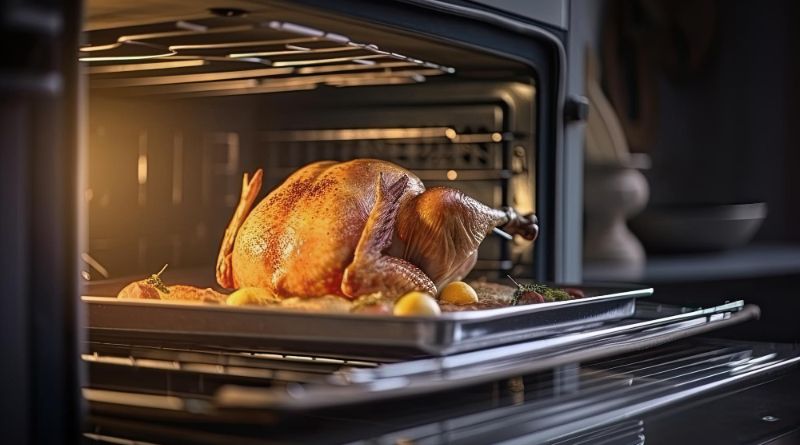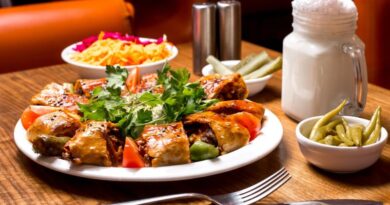These ovens are most often used in restaurants, delicatessens, and other commercial kitchens. A rotisserie oven may have more than a dozen spits when utilized in these kinds of situations. There may be enough room on each spit for a whole turkey or many birds. Cooked poultry may be marketed, served, or utilized in packaged food products. These commercial ovens may cost several thousand dollars and are significantly more expensive than the ones you’d find in the average household.
Several more minor variants are also available for use in home kitchens. These versions often only have one or two spits and may have restrictions on the size and weight of the birds that they can accept. For example, smaller birds, such as chickens and Cornish hens, may only be cooked in a rotisserie oven built for domestic usage. Those big enough to accept turkeys may only roast birds up to a specific size limit. Those that can. For example, a home rotisserie oven may only be able to roast turkeys weighing up to 15 lbs. in weight (about 7 kilos).
- 7 Art Deco Nail Ideas That Give Roaring ’20s Energy
- 8 Home Appliances That Became Obsolete In The Last Two Decades
- 7 Classic Italian Soup Recipes We Can’t Resist
- 7 Best Places to Go in Maine in the Summer for Every Vacation Type
- 7 Easy Tips To Increase Shelf Life Of Dry Fruits
If you’re looking for a rotisserie oven that can cook a wide variety of dishes, look no further than the versions built for household use. Several ovens allow you to cook rotisserie chicken or pizzas by switching out the accessories within the oven. They may be used for countertop baking and broiling, as well.
Onward and Upward
Two to eight horizontal spits are positioned in a vertical cabinet in continuous rotisseries, common in restaurants and supermarket delis specializing in roasted meats. Radiant and convection heating elements are located on the cabinet’s rear, behind each spit. With a low, medium, and high heat setting, employees may control the temperature of each element. It is possible to have a gas burner at the base or behind each spit or a wood-burning hearth built into the base of certain types.
Various types use a chain drive to spin their spits from 3 to 6 rpm. It is possible to alter the spinning speed of the spits using independent motors and gear drives in specific variants.
A cabinet’s depth is generally between 18 and 25 inches, although the width may range from 40 to 90 inches. There are countertop variants roughly 38 inches tall, while floor models may reach heights of over 6 feet tall.
Unlike batch ovens, continuous rotisseries demand a more hands-on approach to cooking because of their construction. As the heat from the radiant elements increases, things on the upper spits tend to cook quicker than the stuff on the lower levels. As a result, it’s common for makers to propose loading from the top spit down, then shifting all spits up one position to ensure that raw product is at the bottom and does not contaminate cooked food. In specific versions, you can roast meat in one chamber and vegetables in the other, allowing you to better control the cooking process.
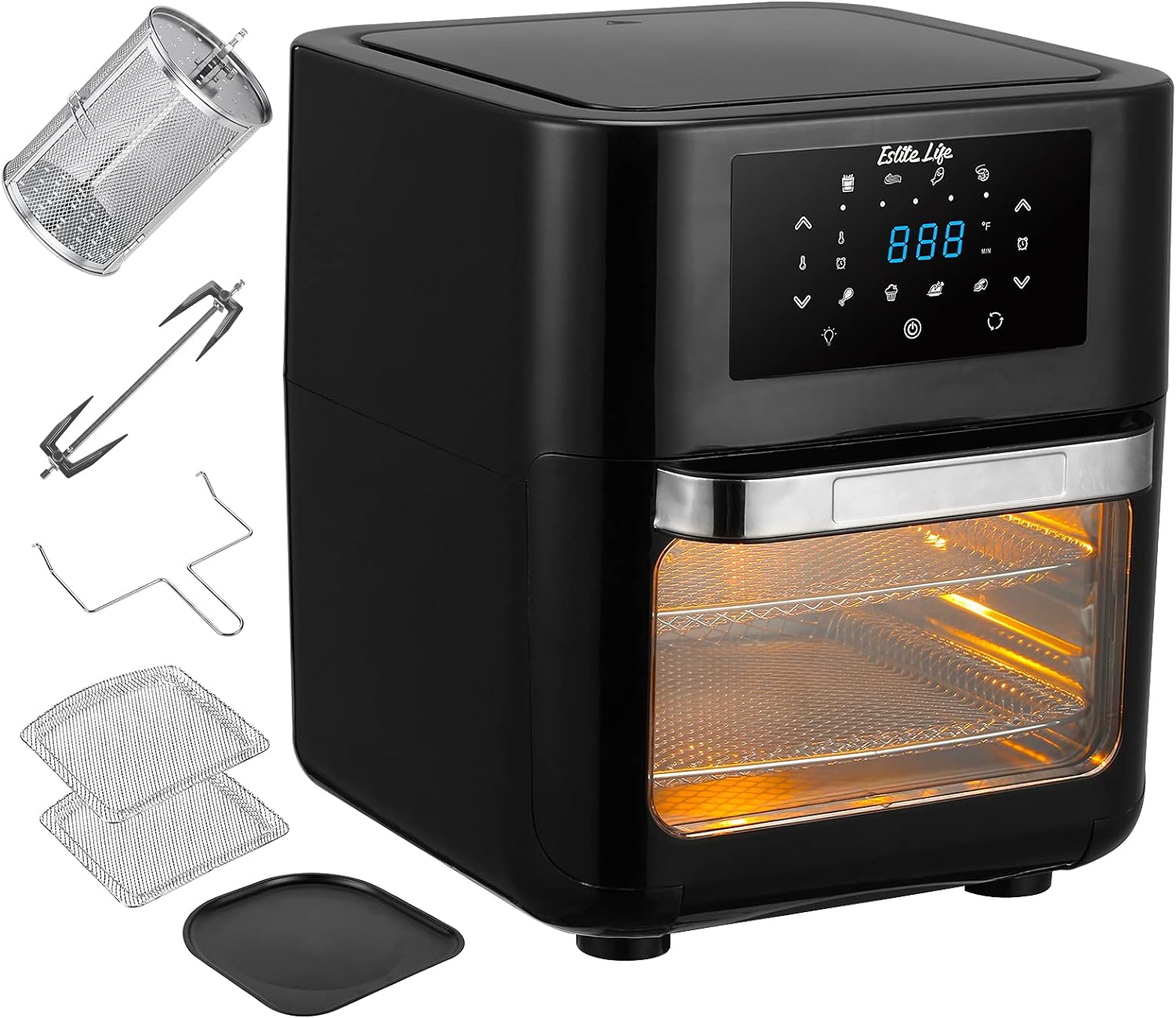
- Special Feature: Automatic Shut Off
- Color: Black
- Capacity: 12.7 Quarts
- Material: Stainless Steel, Acrylonitrile Butadiene Styrene (ABS)
- Output Wattage: 1700 Watts
First-Come-First-Served
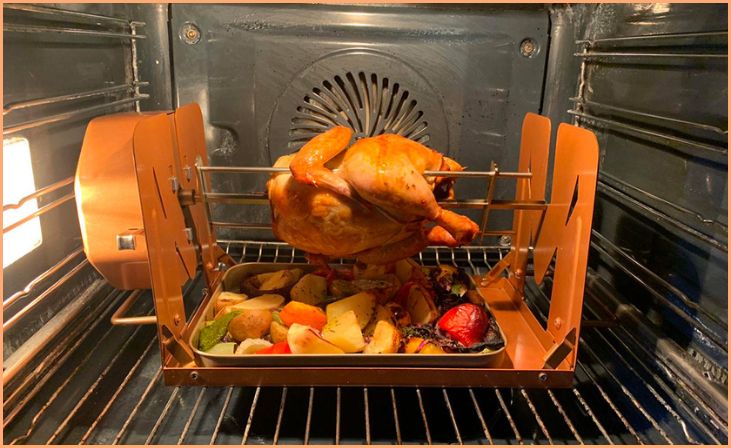
The spits are placed on a rotating drum in a batch rotisserie oven arrangement. On several versions, the spits remain motionless. Radiant components in the cabinet are positioned so that all food surfaces are exposed at some point. Some types include spits that revolve as much as six-and-a-half times every turn of the drum, guaranteeing uniform browning of the food. Check the service records of the models you’re considering to be sure there aren’t any surprises.
Heating the whole cabinet using an electric or gas burner is common in batch models. Employees may control convection and radiant heat sources individually, ensuring uniform cooking on both the interior and the outside. It is possible to design a roasting process depending on the kind of food being roasted.
Convection heating is a method of increasing throughput in batch rotisseries by replacing radiant heating. For example, a continuous rotisserie oven would typically cook a chicken for 90 minutes. In contrast, batch rotisseries seek to reduce that to between 60 and 75 minutes, depending on the size and weight of the bird. In addition, several manufacturers have added moisture to the cabinet and programmability in recent years to make these rotisseries more like combi ovens. As a result, they can now cook a wider variety of dishes to perfection in a shorter amount of time.
In a continuous rotisserie oven, chickens may be cooked for 90 minutes, whereas in a batch oven, it may take between 60 and 75 minutes.
Batch units tend to have smaller footprints than continuous rotisseries, which are more rectangular. Although they’re available in countertop and floor variants, unlike continuous rotisseries, they may be stacked due to their form and size, giving you the same capacity of roughly 80 chickens as a huge continuous rotisserie.
Some rotisserie ovens include a hands-free self-cleaning mechanism that saves both time and water compared to conventional versions. Alto-Shaam has provided this information as a courtesy.
Capacity is a Factor
You should add 15% extra capacity to your manufacturing capacity to handle future expansion as a general guideline. The ability you specify depends on your sales volume. You’ll need a rotisserie capable of cooking roughly 46 chickens in 60 minutes if, for example, you sell 40 chickens an hour.
However, you may wish to take into account additional variables. One is the usage of energy. Even if your business outside of rush hours isn’t as high as what you sell during peak times, having two rotisseries is preferable to running one huge unit all day long if your volume is lower. Another consideration is the food on your menu. Multiple rotisseries allow you to extend your menu while still meeting production demands, whether you desire more menu variety or you currently offer other rotisserie products than simply chicken.
Don’t forget to include the cost of labor. Using 5-foot spits may be an option if you have enough demand, but they typically need two persons for loading and unloading. Your organization may benefit more from a machine with 3-foot spits that only one person needs to operate. It’s also possible that a batch oven might be a better option for personnel who aren’t familiar with operating a rotisserie.
Purchase holding cabinets for cooked food and set up a location for loading and unloading spits, last but not least. Some rotisserie models come with matching hot boxes for commercial purposes.
You might be able to boost sales with a merchandising base item. Henny Penny provided the image used in this post.
Utilities-Related Notes
Before deciding on a model, you need to have a basic understanding of utilities.
Gas rotisseries may burn up to 195,000 Btu per hour, so be sure you have enough gas pressure. High-efficiency burners have been implemented by certain manufacturers, resulting in energy savings of 30%-35%.
Electric rotisseries often need high-amperage circuits. 208V, 220V, 240V, and 400V service voltages are all options. For example, 53.4 amps may be drawn in one phase by a 208V single-phase unit, 33.6 amps by a 208V three-phase unit, and 18.3 amps (or less) by a 400V three-phase unit. The electricity entering your shop should be matched.
Even utilizing a gas burner, you’ll still need an electric connection to power your motors and lights. So again, check to see that the site where the device will go has the proper service and circuit.
The installation of a batch rotisserie requires a water connection, so you will need to install plumbing where the rotisserie will be placed. You’ll also need a drain if you have an automatic wash cycle. However, installing plumbing in a continuous rotisserie is unnecessary since it often feature a water pan in the base that serves a dual purpose: it supplies moisture in the cooking cabinet and collects oil.
Using an electric rotisserie may not need the use of ventilation hoods, but using gas-fired equipment would. Ventless hoods are an alternative if your local fire code mandates one over electric types.
Some gas-assisted rotisseries may be used to provide a smoky taste to roasted dishes by using wood.
Countless Possibilities
Many different options are available when it comes to rotisserie ovens. For example, one unit has a “wall of flame” that truly grabs people’s attention.
Doors come in various configurations, ranging from single-pane hinged doors to double-pane hinged or sliding doors. In addition, customers may choose from multiple batch models with curved glass doors that improve their visibility. On some versions, double-paned glass that is cooler to the touch is available. Mirrored door glass coatings are also available from certain manufacturers.
Pass-thru doors on various versions allow personnel to load the units from the back, keeping the dirty, raw protein synthesis out of the consumers’ view. –
For HACCP data collecting and software downloads, specific programmable versions incorporate USB connections.
In addition, many types of covered or perforated grill baskets may be used to cook fish, vegetables, or pastries. The spits are placed on a rotating drum in a batch rotisserie oven arrangement. On several versions, the spits remain motionless. Radiant components in the cabinet are positioned so that all food surfaces are exposed simultaneously to ensure even browning. Some types include spits that revolve as much as six-and-a-half times every turn of the drum, guaranteeing uniform browning of the food. Check the service records of the models you’re considering to be sure there aren’t any surprises.
Heating the whole cabinet using an electric or gas burner is common in batch models. Employees may control convection and radiant heat sources individually, ensuring uniform cooking on both the interior and the outside. It is possible to design a roasting process depending on the kind of food being roasted.
How to Cook Rotisserie Chicken in Oven?

Traditional techniques were difficult to learn, but using a rotisserie oven is a lot less time-consuming. Using motors in modern rotisserie kitchen small appliances reduces the work of skewering the meat and ensuring it cooks for the right time. In addition, it is better to use a rotisserie oven because the fat drains out of the meat as it rotates, reducing cholesterol and fat content without compromising taste or softness.
Cooking vegetables and fish on a rotisserie is an option, but traditionally, this method is reserved for roasting meats on a spit. Meat should be marinated or covered with spices to produce a typical meal of meat. Make sure the meat is evenly distributed on the skewer so that the motor is not overworked. Since poultry is heavier in the neck than in the legs, this solely affects vertical rotisseries.
Rotisserie ovens take 15 minutes of cooking time for each pound of meat, so be sure you follow the manufacturer’s instructions. In addition, it is critical to use oven gloves to prevent contacting any glass or other metal since ovens may become quite hot when using an oven. You can prepare excellent cuisine in a rotisserie oven if you follow these instructions.
How to Reheat Rotisserie Chicken in Oven?
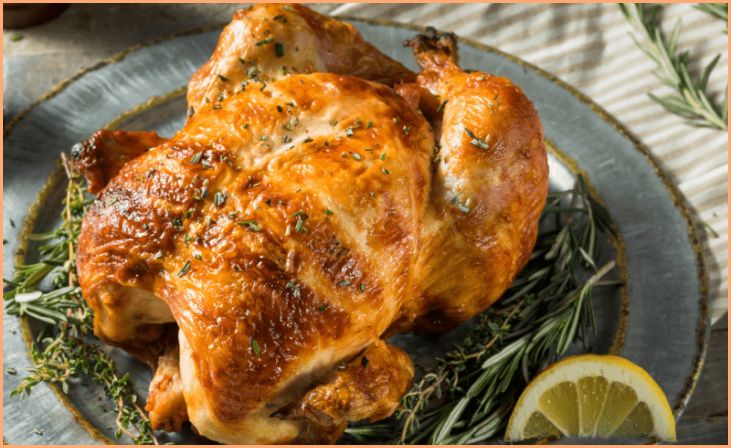
When it comes to reheating huge portions of chicken or a whole bird, the oven is your best choice. What you need to do is follow these steps:
- Preheat the oven. Remove the chicken from the refrigerator and set the oven temperature to 350°F. While the oven is heating up, let the bird rest at room temperature for a few minutes.
- The second step is to add water. Heat the oven according to the manufacturer’s instructions and place the chicken in a baking dish. Make sure the pan has a very thin layer of liquid in it by adding a few spoonfuls of chicken stock or water. Then, cover the pan with a second layer of aluminum foil and secure it in place. Steam from the water will help keep the meat moist.
- Repeat step 3 until the food is thoroughly heated. To cook a chicken, put it in the oven and cook it until the internal temperature is 165 degrees Fahrenheit. (The time it takes to reheat chicken can vary based on the kind you’re using.) Remove the chicken from the oven after it’s warmed through and dish it up—it should be juicy and flavorful. However, if you’re looking for crispy skin, you may just broil your piece of chicken for a few minutes before scoffing down on your dinner.
Final Words
In conclusion, cooking a rotisserie chicken in a rotisserie oven is a wonderful way to achieve a flavorful and succulent result. By following the steps outlined in this blog post and using the right techniques, you can create a delicious and impressive meal. Remember to properly season the chicken, truss it securely, and preheat the rotisserie oven to ensure even cooking. Basting the chicken with flavorful marinades or sauces throughout the cooking process can enhance the taste and moisture of the meat. With a little practice and attention to detail, you can master the art of cooking a rotisserie chicken that will be a hit at any gathering or family dinner.
FAQs
Preheat your rotisserie oven to around 350°F (175°C) for optimal cooking. This temperature ensures the chicken cooks through while developing a crispy skin.
Cooking times can vary, but a general guideline is about 20 minutes per pound. Use a meat thermometer to check for an internal temperature of 165°F (74°C).
Absolutely! Many stores offer pre-packaged rotisserie seasonings that can save you time and effort. Alternatively, you can create your own blend of herbs and spices.
Trussing helps the chicken cook more evenly and maintain its shape on the rotisserie. While it’s not mandatory, it can enhance the overall cooking process.
Also Check:
Copper Chef Titan Pan Reviews: Best Choice in Nonstick Pan

